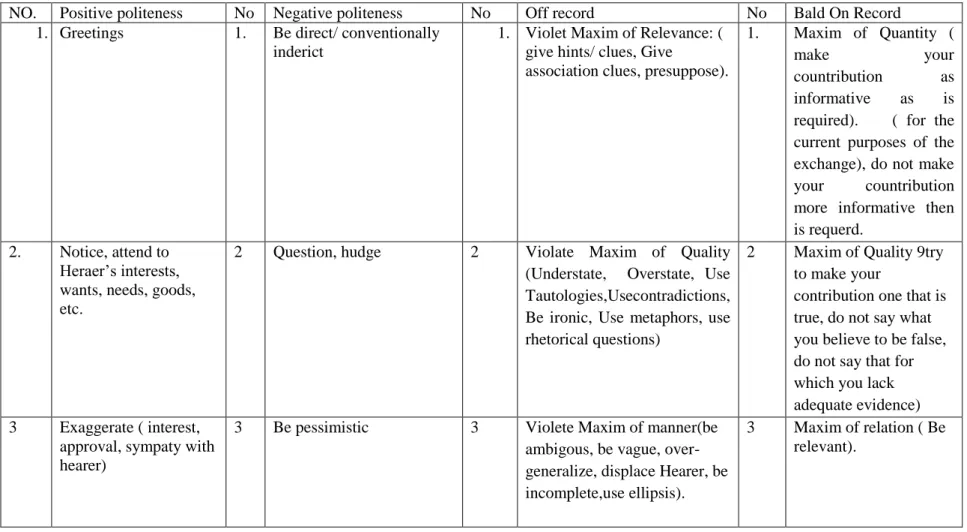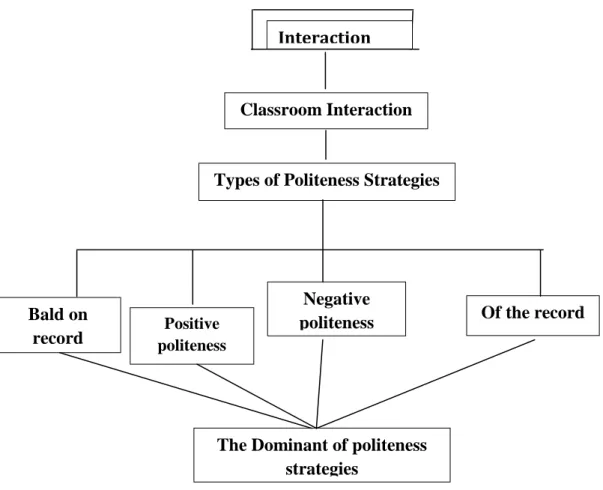For his blessing and heaven sent along with healthy until the writer completes this thesis. The writer would like to express her high respect and sincerely thank her advisers Dr. Andi Tenri Ampa, M.Hum and Andi Asri Jumiaty, S.P., M.Pd. for their invaluable clear perspective, expertise and motivation. to complete this thesis entitled “Politeness Strategies Used by an English Teacher in Classroom Interaction at SMPN 4 Tamalatea”. The writer would like to thank everyone who contributed and appreciated that this thesis could be completed.
My beloved family: My parents, my grandmother and my sister who always give support, prayer and motivation to the writer so that the writer had countless spirit to finish this thesis.
INTRODUCTION
Problem Statements
Objective of the Research
Significance of the Research
- Theoretically
- Practically
What Kinds of Politeness Strategies Does the Teacher Use in EFL Classroom Interaction At SMP Negeri 4 Tamalatea?. In addition, the results of this study are expected to help students learn and interact politely, especially in the classroom.
Scope of the Research
The speaker can satisfy the addressee's positive facial desires by emphasizing that the speaker wants what the hearer wants. It shows that the speaker has saved the listener's positive face because the speaker has involved the listener in the discussion. So the listener's positive face is satisfied because he was appreciated by the speaker.
Do not worry." This example shows that the speaker conveys to the listener that they cooperate. It shows that the speaker has appreciated the listener and satisfied the positive face of the listener. Therefore, the speaker can minimize imposition when he or she trusts the listener.
The impact of politeness strategies
The speaker uses positive politeness strategies because he can satisfy the listener's positive face to some extent (Brown and Levinson, 1992:72). Yule (1996) says that the positive politeness strategy focuses on the supplicant pursuing a common goal and even friendship. The use of positive politeness is evident in the intimacy between speaker and listener.
It can therefore possibly be formed by a courtesy as the speaker's attempt to recognize a face of a listener. The speaker can gain advantages such as, (1) he can minimize the face-threatening aspect of an act by assuring the addressee that the speaker considers himself to be of the same kind; he likes him and wants his desires, (2) he can emphasize friendly context, (3) avoid the guilt implications of FTAs such as request and offers, (4) including the addressee and the speaker equally as benefactor. Thus, although a listener refuses the speaker's needs, the impact is not about pain because negative politeness gives the listener a chance to give a negative response. In this strategy, the speaker can get the following benefits: (1) he can respect, defer to the addressee in exchange for the FTA, (2) he can maintain social distance, (3) avoid the threat, (4) the mutual loss of face to the minimum (5) he can indicate that he wants the other's face in his mind.
However, it can succeed if there is much more in formations expressed by the speaker. In this strategy, the speaker can gain the following advantages: (1) he can avoid entering the gossip biography that others keep about him; (2) he can avoid responsibility for the potentially face-damaging interpretation, (3) he can give the addressee an opportunity to be seen caring for the speaker, (4) he can get credit for being generous and cooperative. Be Pessimistic 3 Violet Maxim of Manner (be ambiguous, be vague, overgeneralize, displace Hears, be incomplete, use ellipsis).
The theory of face-saving politeness has some strategies to save the listeners' face from threat, which include in the utterances Brown & Levinson declare four strategies chosen by the speaker to save the hearer's face, namely the first is "bald on plate", the second is "positive “ politeness”, the third is “negative politeness”, and the last one is “off-record and politeness strategies that are dominantly used by the teacher in the EFL classroom interaction. Based on Sugiyono (2010) who states that qualitative research is descriptive. This method aimed to describe everything related to the subject of the research.

Variable and Indicators
Where the researcher describes the types of politeness strategies used by the teacher and the dominant politeness used by the teacher in the EFL classroom interaction.
Research subject
Research Instrument
In this research, the research will use observation checklist to get the data into the classroom. Observation Checklist is a list of things an observer will look at when observing a class. Furthermore, the Observation Checklist provides a structure and framework for an observation about which types of humor the teacher uses in class.
In addition, the research completed an observation checklist while observing classroom interaction based on the occurrence of politeness strategies in the teacher's statements. The interview used Bahasa Indonesia to talk to the interviewee to avoid miscommunication and to get the researcher's natural data.
Data Collection 1.Observation
Data Analysis
In the process of data reduction or reduction, qualitative data can be transformed and simplified in several ways. This means that data reduction is the process where the researcher identified and selected the most relevant part related to the topic. So the analysis focused on the data that are relevant to the research questions that have been formulated.
The researcher concluded the type of politeness strategies used by the teacher in EFL classroom interaction.
RESEARCH FINDING
Discussions
Based on the 18 excerpts analyzed in the finding, 4 types of politeness strategies were found; namely positive politeness, negative politeness, bare on the record, and off the record. This is reflected when the teacher gives respect to the students, even though they made a joke. For example, when teacher used the statement "Tot jou, tidak cukup ko itu kalau satuji na besar badanmu" when students make a recipe, but one student or group friend makes a recipe just a little, but because the body of the student fat, so the teacher makes a joke to the student The second finding shows that positive politeness in extract then 17.
Here the teacher used these types with different strategies. The strategies used in the group: paying attention to Heraer's interest, want, needs, goodness, giving gifts, being obtimistic, joking and showing understanding. Because students have done good and right practices, the teacher gives a gift to the students who have used the politeness strategy through sympathy. Then, for extract 12, Postive Politeness, the utterance “Okay from group one you get score ninety” This utterance gives the teacher a score to each group, gives the teacher a rating according to the teacher's assessment indicators, such as how well to practice, structure, good cooperation with their group friends, and at the end the teacher gives the score of each group.
Positive Politeness/Offer the teacher uses expression “siapa yang bisa buatkan konsumer atau konsumer dari materi kita hari ini” based on the above sentence it shows that the teacher uses the positive politeness to use the offer strategy. To help the teacher's self-evaluation process, students are also expected to play a role in it. The measure of teacher success in teaching is students. So if we want to know to what extent our success in teaching is one of the ways to present students, such as saying "siapa yang bisa buatkan slot atau conclusion dari materi kita hari ini".
The teachers used this type of explanation but the students don't understand, but the teacher used "sudah SMP masa belum tau" to express his opinion, but the word "negative" here means "bad", it is the opposite pole of "positive" . ', which can be defined as a face storage device, specifically for the negative face. This strategy is partly a non-record strategy, although it is quite different with a bald record, which is defined as a strategy that does not require any effort by speakers to minimize the impact of FTAs, and the researcher defines a non-record strategy as a strategy that is in contrary to baldness in the application of maxim theory.
Conclusion
Suggestion
Is politeness important in English language learning during teaching and learning activities in the classroom. What is your opinion about the interaction between other teachers and students during the class. Is there a difference in the way you communicate with the student in class and outside of class?
T : Okay anak-anakku sekalian eee today we will practice how to make a simple resept jaah now please each group take your ingredient ( ambil ingrediennya) take now coba please take your ingredient ( ambil your ingredient yang you bawa ) okey put it on the table. Okay, before we start, yes, (the teacher writes about MAPEL on the board) Attention. T : Second, harusnya toh put coffee in a glass, just like that hanya seperti itu.Kenapa banyak sekali langka-langka mu.Okey do it now please.Who is reading, siapayang membaka ?practice now okey. Okay, from the second group, how to make ice pops, you get an eighty-five. Okey and the group tree you also get eighty-five points. You are the same with the other group yes why.
T: Okay, the bell rings, it's time to stop, it's time to stop, it's study. Okay, pick up your book, kumpulkan bukunya. Okay students, let's say Alhamdulillah S: Alhamdulillah. Researcher: Is politeness important in teaching EFL during classroom teaching and learning activities. Researcher:How to behave politely during the teaching and learning activities in the classroom.
Researcher:What is your opinion about the interaction between the other teachers and students during the lesson. Researcher: Is there any difference in the way you communicate with the student in and outside the classroom? Researcher:How to behave politely during the teaching and learning activities in the classroom.
Researcher: Is there any difference in the way you communicate with the student in class and outside of class.
